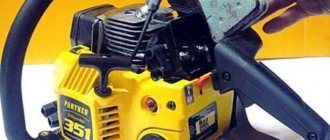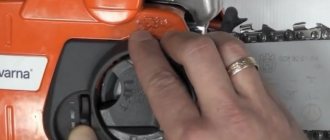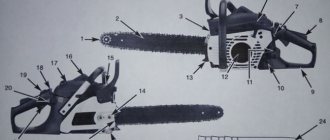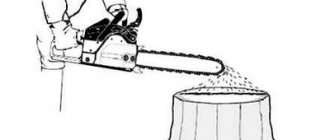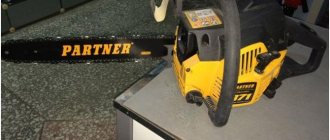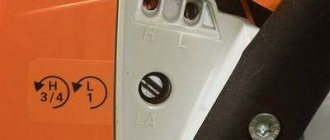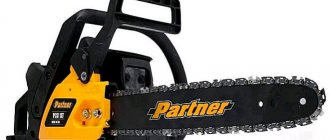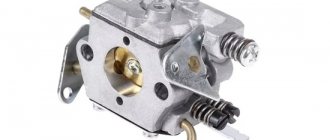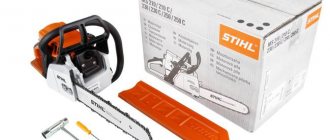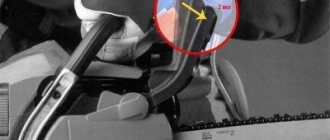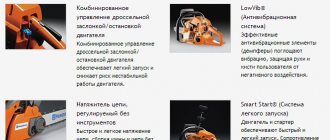The structural system of each similar unit, if we talk about chainsaws, is almost the same. But this is under the eyes of a professional. For the average user, it can be difficult to distinguish different types of filters, parts elements, especially the types of fastening and the obligation to return them to their original cells. This is quite natural. Many operators today are interested in disassembling the Pertner chainsaw themselves, so we offer step-by-step instructions and a detailed video. Often information on how to disassemble Partner comes in very handy if the service center is not available to you. The saw owner is also interested in assembling the unit, because further work depends on its correctness. Gasoline tools from the manufacturer Partner are currently among the top five popular and high-quality saws, and using the popular models 340S and 350S as an example, we will consider the procedure itself. KosiKosa offers spare parts for chainsaws of this brand, as well as other powerful manufacturers, so that any work process brings you only good results!
Troubleshooting common problems
The Partner 350 has popular faults that owners of these saws can diagnose and fix themselves. Let's take a closer look at popular faults and how to repair them yourself.
Stalls when you press the gas
If the Partner 350 stalls when you press the gas, then most likely there is a problem with the fuel system. The most common breakdown is an incorrectly adjusted carburetor or its malfunction, as well as extraneous air leaks.
Tip: If the chainsaw stalls when the speed increases, you should not immediately adjust the carburetor. Start by checking the engine for foreign air leaks. One of the signs of air leaks is increased idle speed.
Starts and stalls
If the Partner 350 starts up and immediately stalls, then, as in the previous case, there may be several reasons, but the most common is a difficult fuel supply. You should start troubleshooting by checking the condition of the fuel filter and lines. If the fuel flows normally, then check the spark and try to start the chainsaw on a new spark plug, as the saw may stall due to interruptions in sparking.
It is also necessary to check the draft of the air damper. If it does not open the air damper or does not open it completely, the engine may stall due to excessive fuel enrichment.
Lack of chain lubrication
There are several reasons for the lack of lubrication supply on the Partner 350 chainsaw, and in this case we can list them all.
- Oil line rupture.
- Oil filter clogged.
- Defective worm drive gears.
- Line or pump clogged.
How to solve oil pump problems is described above.
Pouring a candle
A very common problem that owners of Partner 350 have to face. The first place to start checking is to replace the spark plug with a known good one. If it doesn’t help, the spark is good, but the engine floods, then the reason is hidden in the carburetor settings. Instructions for diagnosing and adjusting the carburetor for the Partner 350 are on our website.
Problem: chainsaw stalls after starting
A common situation: the Partner chainsaw stalls at high speeds, although before that it starts and runs without problems at medium gas. Sometimes at medium it also works intermittently - but at full throttle it immediately stalls. This problem is faced by many users who save on quality fuel.
Low-quality gasoline easily contaminates parts with soot. In this case, checking the filters (air and fuel) will not hurt. Moreover, the muffler suffers from poor fuel and the carbon deposits it creates.
READ Chainsaw Carver 252 Carburetor Adjustment
The combustion products of dirty fuel simply clog it, forming an impenetrable plug of soot. This plug greatly reduces engine power. In this case, gasoline is consumed in large quantities, but there is no result in power. Check and clean the muffler:
Breather clogged
The breather of the presented model becomes clogged when low-quality fuel is used. In such a situation, repairing the Partner 350 piston chainsaw should begin with inspecting the carburetor. In order to see it, you will have to remove the top cover of the device. Next, the ignition module is twisted
After this, it is important to immediately disconnect the crank. In this case, you will have to use the keys
The next step is to disconnect the drum.
Immediately behind it is the carburetor. There is no need to remove it for inspection. First of all, the throttle is checked. In some cases, this may be the problem. If the throttle is fine, you need to look at the tire. When it is damaged, its sides are slightly knocked down. Cracks may also be observed in the central part of the tire. If the part is deformed, it will have to be replaced. It is better to purchase spare parts for the Partner 350 chainsaw in specialized workshops. It is quite difficult to install a tire on a carburetor yourself. In such a situation, it is more advisable to contact a specialist.
Chainsaw Partner 350: DIY repair, video
Today, almost every household has a chainsaw, which is a worthy replacement for axes and hand saws. The ideal solution for people living in a private house or involved in construction would be the Partner 350 hand chainsaw. This tool from a Swedish manufacturer is very convenient and compact, so it is suitable for any work in the garden.
However, improper care and intensive use of the unit can lead to its breakdown. In this case, it is not necessary to immediately contact a service workshop. Many problems can be fixed with your own hands. To do this, just study the structure of the saw and video instructions for its repair.
Chainsaw troubleshooting
Experienced fellers know that competent and accurate determination of the nature of the breakdown is half the repair work done. Based on many years of experience in repairing Partner 350 chainsaws, specialists have developed a special method for diagnosing problems.
Major breakdowns of the Partner 350 chainsaw
It is worth starting from the simplest components and mechanisms, ending with more complex ones.
This allows you to significantly save time and avoid unnecessary operations. Troubleshooting is recommended in the following order:
- Checking the chainsaw spark;
- Ignition coil;
- Diagnostics of the fuel supply system;
- Inspection of crankshaft bearings.
Checking the spark at the spark plug electrodes
To diagnose the presence of a spark, it is necessary to remove the spark plug and, without removing the high-voltage cable, make several jerks with the starter. If there is a discharge, you will need to set a gap between the central and side electrodes. Its value in Partner 350 should not extend beyond 0.7 to 1.2 mm.
Adjusting the spark plug gap with a feeler gauge
A lack of this distance can lead to incomplete combustion of the fuel mixture and, as a result, increased fuel consumption with limited power of the unit. As a result of exceeding these parameters, inconsistency in the occurrence of a spark and interruptions in the operation of the internal combustion engine are observed.
If there is no spark at the electrodes, it is necessary to replace the spark plug and repeat the diagnostic procedure described above.
If a discharge is also not observed on the replacement spark plug, it is necessary to check the integrity of the high-voltage wire and, if necessary, replace it.
Diagnostics and ignition adjustment Partner 350
The absence of a bright blue spark in the spark plug may indicate the need to inspect the ignition module and adjust the gap. For these purposes, remove the plastic protective casing from the saw and check the condition of the coil. The wires leading to it must be firmly fixed with screws and must not dangle at the connection point. There should be no moisture on the flywheel of the drive shaft, as it interferes with the generation of the electromagnetic field.
Flywheel and ignition module of Partner 350 chainsaw
If there are no such discrepancies, you must ensure that the gap between the module and the flywheel is set correctly. Its value should be no more and no less than 0.2 mm, and therefore if it does not coincide with the recommended distance, you will need to independently adjust the ignition of the Partner 350 chainsaw.
For the most accurate adjustment, you will need a regular coin-shaped or flat probe, which can be purchased in specialized or automotive stores.
After checking the ignition, we move on to diagnosing the fuel supply system.
Chainsaw fuel system 350
An important influence on the correct operation of the saw is played by the fuel system, consisting of a gas tank, pipes and a carburetor.
Carburetor Partner 350 disassembled
If the mixture does not flow from the tank, you need to inspect the built-in filter and breather (hole in the lid). If the fuel filter is clogged, it will need to be replaced. To clean the breather, you can use a regular sharp needle, carefully removing any remaining dirt and sawdust from the valve. If the carburetor becomes clogged, it will need to be dismantled and thoroughly cleaned.
It must be remembered that the partner chainsaw carburetor is a complex assembly consisting of many small parts
Therefore, maximum care must be taken during dismantling, cleaning and assembly.
The principle of operation of the carburetor
The carburetor is used to mix the fuel mixture (oil and gasoline) with air. Its work begins from the moment the saw starter jerks, which forces the membrane to pump fuel. A diaphragm-controlled needle valve then supplies gasoline to the main chamber, through which it enters the cylinder. By means of the throttle valve, you can “enrich” or “lean” the fuel mixture with air. When it closes, less air will enter the cylinder at the same fuel level. In this case, consumption will increase coupled with a drop in engine power. Therefore, adjusting the Partner 350 chainsaw plays an important role in creating the optimal balance between moderate fuel consumption and high tool performance.
It is recommended to do the setup yourself only if you have special tools and skills.
Repair and operation of chainsaws Partner 352, 371
When assembling the Partner 352 chainsaw, can I use old gaskets or do I have to use new ones?
In general, of course, it is recommended to install new ones. But again, it depends on what kind of gasket it is. If, say, a large saw has a crankshaft housing connector gasket, a new one should definitely be installed. Under the cylinder (if the design has one) - always new. It would be nice to have a new one under the thermal insulator, especially since they almost always get damaged. You can use the old one under the carburetor if it is not deformed or torn. You can also use an old one under the muffler - it’s okay, even if it’s not dense, it will be overgrown almost immediately.
Chainsaw Partner 371 new, one month of operation. It starts from half a turn, runs perfectly at idle, but when you give it gas, it stalls. And sometimes it takes 2 tanks of gas and it works fine. Has anyone had this problem? Can you tell me what it could be and what to do?
I have this when I have less than half a tank of gas and I drink horizontally.
The Partner 371 chainsaw has an 18″ tire, I wanted to install a 16″ tire - does it make sense, and how will this affect the saw? If such a replacement can be made, then which tire is better to install?
The advantages of such a replacement. The saw will be lighter and more maneuverable. The center of gravity of the saw will shift a little closer to the rear handle, making sawing more convenient. It will also be more convenient to work with the end of the tire. A shorter chain is cheaper and quicker to sharpen. Minus. The cut length may not be enough when sawing in cramped conditions, for example when sawing fairly thick logs piled up in a pile. First of all, it is necessary that the new tire has the same shank as the old one. If you have an Oregon tire installed, then there should be a marking stamped near the shank. In the specified article, the first two digits indicate the length of the tire in inches. It is enough to replace “18” with “16”. Example, 180SDEA is stamped, which means you need a 160SDEA tire.
Tell me about the fuel filter that is in the tank, I looked at it, I didn’t see anything filtering, some kind of heavy ceramic flask. Maybe there is no filter at all? Is the carburetor difficult to disassemble?
There is a filter there (the bulb is the filter), the Partner is still not one of the worst chainsaws. It is unlikely that you need to disassemble the carburetor - the saw is new. Adjusting and disassembling are two different things.
What is the oil consumption of the Partner 352 chainsaw? After filling up the gas tank twice, I noticed a sagging chain. I unscrewed the oil cap and it was empty. poured another 150 ml. How to refuel?
Refuel in the following order: Fill the oil tank first, and only then add fuel. In this case, if you forget to add the fuel mixture to the tank, the saw will simply not start or will stall a short time after starting. An empty oil tank will only be discovered after the chain and bar have overheated. The oil consumption and the volume of the oil tank are calculated by the manufacturers so that after the fuel is used up, there is still oil left for lubrication, but one oil tank is never enough for two tanks of fuel. If the oil consumption on the saw is within these limits, then everything is normal.
I have a Partner 371 chainsaw, and lately the filter mesh in the carburetor has been constantly getting dirty. where does the dirt come from?
There are two ways to contaminate the mesh: through the impulse channel (if the air filter does not hold well) and through the fuel line. If the gasoline filter is old, replace it, wash the gas tank and fuel line. And this must pass.
I am repairing the fuel system of a Partner 352 chainsaw. Where is the mixture prepared (air mixed with fuel)? Where is the throttle valve right? What causes fuel to be injected through the valve injector towards the cylinder? What function does the jet perform?
Right where the throttle valve is. The piston sucks in air. The mixture is sucked in through the nozzle and sprayed with the same air. Operating principle of a jet pump. Or rather a spray gun. The vacuum of air in the carburetor forces the mixture to be injected. Because the piston, when it goes up, creates a vacuum. The jet plays the function of supplying the fuel mixture to the air. This is a very precise part with a set diameter, designed for the correct ratio of the fuel mixture and air, turning it into a fuel-air mixture. The small hole at the bottom of the cylinder is the impulse channel. By discharging the air, the piston forces the membrane to move, thereby pumping the fuel mixture from the tank. The primer should be on the return hose; it pumps gasoline (fuel mixture) through the carburetor back into the tank, thereby making starting easier. If there is no primer in the saw, then fuel is pumped from the tank into the carburetor by a diaphragm inside the carburetor. It takes more jerks to start the engine without a primer.
Drum repair
Breakage of the ram in the saw is accompanied by a loud sound when turned on. In this case, repairing the Partner 350 chainsaw with your own hands should begin first of all by inspecting the fuel system. The problem may be a broken carburetor. In some cases, the drum will fly out due to the crank coming out of the grooves. In order to inspect it, you need to open the protective cover. Next, the throttle is removed and the fuel system is checked.
All tubes must be connected. After this, you need to inspect the crank, which is located above the carburetor. If it has fallen off the grooves, you can straighten it yourself. However, if it is severely deformed, it will have to be replaced. The drum in this saw is located near the air damper. When it hits the coupling, its protective ring is damaged. If it is completely worn out, then the drum will have to be completely replaced. In this case, you need to know the product labeling. The installation of the drum is quite simple, and you can handle the installation yourself
In this case, it is only important not to damage the fuel system during repairs.
Video: Assembling the Partner 350 Chainsaw
The condition of all elements of this group can only be fully assessed visually through the hole from the removed muffler. If possible, remove the cylinder head or the entire cylinder.
If the cause of the chainsaw breakdown is minor, it does not matter. The instrument is made by Russian or Chinese manufacturers. Disassembling and repairing the device can be done quite easily by yourself after studying the design instructions and troubleshooting videos.
Source
The Partner 350 chainsaw is a “relative” of the famous Husqvarna brand, since Partner is a subsidiary of Husqvarna. Lightweight and convenient, reliable and simple, Partner 350 is widely used in cottages and private homes. Pruning branches, branches, cutting down trees. This is not a complete list of jobs that can be done easily and effortlessly with a saw. A brief overview will help you get to know this in more detail.
Features of disassembling the Partner saw
Like any equipment and procedures with it, disassembling the Partner saw involves some features that its owner should be aware of. You can learn a lot from our videos, but you should focus on the following nuances:
- The crater cover is installed without a gasket, but instead it is worth applying red sealant with a thin ball. Be sure to degrease both surfaces first so that they have better contact;
- use a special puller to remove the flywheel, although many specialists have adapted to using a wrench and lightly tapping with a drift;
It is not at all difficult to disassemble the Partner saw, relying on high-quality videos and step-by-step recommendations from our service specialists. In general, this mechanism consists of similar elements as most user-level chainsaws. Therefore, its disassembly and reassembly will not be difficult for you. The Kosi Kosa petrol tool store is pleased to offer you high-quality tools, as well as informative articles on the operation and repair of mechanisms.
Adjusting the carburetor of a Chinese chainsaw with your own hands
Adjustment is not provided on all carburetors of Chinese chainsaws. Today there are many models of household chainsaws, including European brands, whose carburetors simply do not have adjusting screws. Or there is only one idle speed adjustment screw.
Such carburetors require adjustment only when the chainsaw at idle makes too few emissions (revolutions) and sometimes stalls. Below in the text we will discuss the algorithm for adjusting the idle speed of the carburetor on a Chinese chainsaw.
Required Tools
Adjustment requires a screwdriver that fits the slots of the adjustment screws. On different carburetors they are flat, cross-shaped, with an internal or external hexagon, an asterisk, etc.
Carburetor adjustment algorithm
Before making adjustments, make sure it is necessary. All Chinese carburetors on each chainsaw undergo factory settings, which rarely go wrong. A new carburetor, or in rare cases an old one, may require adjustment.
The cause of deterioration in engine performance with symptoms similar to poor supply of the fuel mixture is, in most cases, the following:
- clogged air filter,
- exhaust windows and muffler clogged with carbon deposits,
- bad fuel.
If this is not the problem, then try adjusting the carburetor.
The engine must be warm. A cold engine and one warmed up to operating temperatures operate differently. Therefore, adjustment in cold conditions will be incorrect.
- Provide access to the adjusting screws. On some chainsaws, it is enough to remove the cover and air cleaner. On others you have to remove part of the body. On the third, the housing has holes for a screwdriver.
- The screws are marked on the carburetor or near the holes - T (or LA) L and H. The T (or LA) screw is designed to adjust the idle speed. Always located away from screws L and H, which are next to each other.
- If the chainsaw stalls when gas is supplied, the engine does not have enough fuel to develop speed. The amount of fuel is adjusted using screw H (main screw). Unscrew it 1/4 turn and give gas. If the engine begins to work better, unscrew it another 1/4 turn. (If worse, then tighten it 1/4 turn in the opposite direction).
- If the engine starts to idle, it means there is a lot of fuel, screw H is screwed back.
- The peak speed is controlled by ear or using a tachometer. The maximum speed for each chainsaw is indicated in the instructions. (10,000 – 12,500 rpm). In practice, 10,000 – 11,000 rpm in the “full throttle” position are normal values.
- By increasing the amount of fuel supplied with screw H, the quality of the fuel mixture is adjusted with screw L. It increases and decreases the amount of air in the mixture. If there is not enough air, the fuel will not burn out; as a result, the engine smokes, does not develop power and consumes excess fuel. Screw L also affects engine operation at low and medium speeds.
- After adjusting screw H, screw L is unscrewed 1/4 turn. If there is smoke in the exhaust and the engine moves from low to medium and high speeds with dips, screw L is unscrewed some more.
- Adjustment of screw L is stopped when the engine runs smoothly, moves smoothly from low to high speeds and does not smoke.
The location of the adjusting screws is highlighted with a red square. To access them, a screwdriver is enough. There is no need to disassemble anything.
Idle speed adjustment
Idle speed adjustment sequence:
- The engine is started and warmed up for 5-7 minutes.
- The screw is unscrewed, increasing the speed until the chain begins to rotate.
- Then the screw is screwed back 1/4 turn.
If you have an electronic tachometer, you need to use its readings when making adjustments. Most chainsaws should idle at 2500 rpm.
Nuances that arise in the process
Screw L should not be unscrewed too much relative to screw H. This will lead to the formation of a lean air-fuel mixture (not enough gasoline - too much air). With such a mixture, the piston is dry during operation, gets very hot and can fail.
New carburetors on Chinese chainsaws, sold separately, are adjusted at the factories to a standard number of revolutions or arbitrarily. Therefore, they may require adjustment after installation on the chainsaw.
Adjustment video
The author of the video shows the process of adjusting a classic Chinese chainsaw with a power of 2.8 kW and a working volume of 45 cubic meters. see. The author talks in detail about all the stages of setup, what screws are there, what they are responsible for and how to adjust them correctly. The whole process takes place without removing the carburetor itself from the chainsaw.
How to start a chainsaw
The effectiveness of any tool directly depends on compliance with the rules of its use. First of all, this concerns the launch. This should be done in the following sequence:
- Apply the chain brake by pressing it forward.
- Remove the protective cover from the tire, if equipped.
- Turn on the decompression valve, which will make the starting process easier.
- Press the fuel choke. This is necessary to reduce the number of swaps.
- Set the combination lever to the idle start mode all the way down, having previously locked the gas lever.
- Place the tool on a flat surface, grasp the chainsaw with both hands so that the cutting part is located at a distance from this surface. In this case, place your left hand on the handle, and your right hand near the starting cable. The tool needs to be secured with your foot, for which you can simply step on the back handle.
- Now the starting rope must first be pulled tight and then pulled several times. In this case, you need to move upward from the body.
- As a result of a short start, the engine will stall. Therefore, after this, the combination lever must be moved up one click, and then started again.
- If the engine is running, the throttle lever must be pressed and the combined engine must be switched to idle mode.
- Now the chain brake needs to be removed and you can start using the tool.
Despite the simplicity of the process, situations may arise when the chain saw still does not start. The reasons are not always related to tool failure. Perhaps not enough force was applied. If, after several attempts, the startup is unsuccessful, it is worth conducting a thorough inspection of the device.
Device
The general arrangement is made in a traditional style. It is characterized by simplicity, which means high reliability of the device.
The diagram of the general structure of the Partner 350 chainsaw clearly confirms this.
Starting the engine is simple and reliable. This was made possible thanks to the presence of electronic ignition. The primer (fuel priming pump) plays an important role during startup.
The air filter is equipped with a double air purification system. Due to the starter drum being equipped with an impeller, large debris particles do not enter the filter at all. This increases its service life and increases the degree of air purification. Overall, this has a positive effect on engine performance.
Safe handling of the working saw is achieved by the presence of a chain brake operating in two modes. Manual and automatic.
The oil pump only turns on while sawing. This means that the chain lubrication system is in automatic mode. Keep in mind that different types of oils are used to lubricate the chain and prepare the working mixture. Find out what oil is used to burn the Partner 350 chainsaw
They sawed the chains. The Partner 350 saw is equipped with an Oregon 91P052E 3/8″ 1.3mm 52 chainsaw. Valid replacements: Stihl 39970000052s and others. For example, Husqvarna 5776151-22. With a 3/8″ chain pitch and 1.3mm groove width, ensure that the link count does not exceed 52. Anything less (46-50) may not be desirable.
The anti-vibration system on the Partner 350 is a bit harsh. Due to the fact that this saw is not intended for professional use, the system as a whole can be considered satisfactory. By the way, the following models have made significant improvements in this regard.
User guide
The instructions contain recommendations according to which the owner of the Partner 350 chainsaw will not have problems when handling it. Safety measures and rules for using the product during operation are described in detail. Issues of repair, maintenance and care of the Partner 350 chainsaw are discussed.
Types of chainsaw repairs permitted independently are determined by the instructions. All other faults are repaired in a specialized workshop.
The instruction manual should always be at hand, especially if this is your first chainsaw and you just bought it. First of all, be sure to read it and seek help if you have any questions while using the tool. Download and print the Partner 350 Chainsaw manual below.
Specifications
According to its data, Partner 350 belongs to the household (amateur) type and fully satisfies the needs of any consumer. To get a general overview of the chainsaw, just look at its main characteristics.
Characteristics of Partner 350
For those familiar with chainsaws, one glance is enough to determine the character of the 350 Partner. A fairly powerful engine and a decent length of tires mean that this will be an indispensable assistant on the farm, but it’s hardly suitable for professional felling.
Design features of the Partner 350 chainsaw
A reliable and easy-to-use saw of this model has a gasoline engine with a power of 1300 W. It is distinguished by easy starting, which is carried out due to the built-in professional fuel pump and electronic ignition system.
The chainsaw is equipped with a safety system that automatically activates a double inertial chain brake. The chain is also automatically lubricated. You can very easily change the chain tension of this unit using just two keys.
The chainsaw is equipped with a fuel primer, making it easy to start at any time of the year. The starter drum of the tool is equipped with a special impeller, with the help of which it is cleaned of contaminants.
A filter with a CCS system is able to capture all residual particles. In addition, this system allows you to use the air filter for a long time, while saving fuel consumption.
The piston group cylinder walls were equipped with a chrome coating, which significantly increases the service life of the tool.
Characteristics
Using a “Partner 350” chainsaw with a 1.8 hp engine. allows you not to worry about the chain jamming, making it possible to carry out the necessary volumes of work on collecting firewood or conducting construction work. This is ensured by an automatic inertia brake and chain lubrication during operation.
The CCS system with a powerful air filter allows the unit to be cooled in a timely manner and prevents it from overheating. The saw has low production noise due to a properly designed housing that dampens it.
Read a useful article with a review of popular models of pole drills here.
The available 3/8" chain pitch allows the applied load to be evenly distributed. The fuel tank capacity of 0.4 liters provides the necessary amount of fuel for long-term operation, and does not burden the design of the saw with a weight of 4.7 kilograms. The engine capacity is 34 cc.
Instructions for disassembling the Partner 350 chainsaw
First of all, the top cover of the chainsaw body is removed, then you can begin to separate the foam rubber on the surface of the air filter. The entire device and elements are bolted, which makes it more practical to use the unit without fear of damage under heavy loads.
Using adjusting screws, the carburetor is adjusted, each of which performs its own function:
Helps adjust top revs.
The essence of the setting: clockwise we increase the number of revolutions, counterclockwise we decrease it.
It should be noted that overheating of the chainsaw is excluded, even with a large volume of work performed, due to the powerful air filter and the base metal in the carburetor body.
The practical and simple device allows you to use the Partner 350 chainsaw in a wide variety of conditions. However, in order to extend its service life, it is necessary to use high-quality lubricants (they are a couple of hundred rubles more expensive than their Chinese counterparts).
But the damage caused by using the wrong oil can cost you the value of the chainsaw itself. Also, do not forget to drain any remaining fuel from the tank if you do not plan to work within the next week.
By following these care recommendations, you may never need repairs at all.
Below, we invite you to watch a video on how to repair a Partner chainsaw with your own hands:
Sources:
https://sad-doma.net/inventar/remont/remont-benzopilu-partner.html https://benzopilok.ru/brend/partner/350-benzopila.html https://6sotok-dom.com/instrumenty/ remont-benzopilu-partner-350.html
Starter problems
The starter fails quite often. In this case, repairing the Partner 350 chainsaw with your own hands must begin with the following: unscrew the side cover, which is located next to the gearbox. The starter for the presented saw is located near the engine. In order to inspect this part, the air damper is first removed.
Next you will need to disconnect the carburetor. The starter in this model is connected to the throttle. To separate them, you need to use a screwdriver. If carbon deposits are visible on the starter, this part will have to be completely replaced. In this case, the usual modification is installed, and finding it in the store will not be difficult. However, it is best to purchase spare parts for the Partner 350 chainsaw in specialized workshops. After replacing the starter, all that remains is to screw the throttle back on and install the carburetor with a cover.
Replacing the connecting rod mechanism
The connecting rod mechanism of the Partner 350 chainsaw is quite complex. Its malfunctions are often accompanied by loud engine operation. It should also be noted that when the connecting rod mechanism breaks down, the carburetor often fails. In this case, it is more expedient to start repairing the Partner 350 chainsaw with your own hands by inspecting the ignition module. You will also need to fully check the coupling. In particular, the condition of the centrifugal clutch deserves attention.
In order to inspect it, you need to remove the top cover. The clutch itself in this model is located near the carburetor. To get to the centrifugal clutch in the saw, the flywheel is removed. Next, the carburetor head is disconnected
In this case, it is important not to damage the fuel system. The centrifugal clutch is bolted on
This part can be disconnected using a key. If cracks are visible under the cylinder, then the clutch will have to be replaced. However, some experts advise not to rush into this. If the cracks are shallow, you can try to grind the surface a little with a file.
Common Partner saw breakdowns: diagnostics at home
The Partner gasoline saw cannot be called unreliable. For many users it works without problems in winter and summer, for many years. But others complain about the same typical problems:
- The chainsaw won't start.
- The chainsaw starts but stalls.
- Fuel does not enter the cylinder.
Disassembling the Partner 340S/350S chainsaw
All these problems have internal causes in the parts and components of the tool. This means that in order to get to the bottom of it and fix the breakdown, you will have to disassemble the electric saw. This is not as difficult as it may seem, because manufacturers always take this possibility into account.
To independently diagnose problems at home, you need to understand that common chainsaw problems in the vast majority of cases are caused by the same reasons. Therefore, just by the symptoms, you can guess where the source of the problem is.
For example, if a chainsaw does not start, then the reason most likely lies in the ignition system, namely the spark plug. If air leaks into the cylinder, then you need to look for a defect in the fuel system. A dirty filter causes the engine to stall and smoke, and so on. Let's look at these cases in detail so that you feel confident when repairing your Partner chainsaw yourself.
Diagnostics of chainsaw Partner 350
Correct identification of a malfunction is already more than half of the repair. In case of malfunctions related to the fact that the saw does not start, the essence of the diagnosis is to check the spark and the presence of fuel in the cylinder, since in the chainsaw there is either nothing to burn or nothing to set on fire.
Spark test
To check the spark, you need to unscrew the spark plug, install it in the cap of the high-voltage wire and attach it to the cylinder (there should be ground on the spark plug). Next, pull the starter several times, while carefully looking at the spark plug. There will be no spark if the Partner 350 chainsaw has faults such as:
- defective spark plug (can only be eliminated by replacing it with a known good one);
- broken wires in the system;
- malfunction of the ignition control button;
- defective ignition coil;
- no gap between the coil and the flywheel;
- broken key between the crankshaft and the flywheel.
Checking the fuel
The first sign that the cylinder is not getting fuel is a dry spark plug. Having discovered a dry spark plug, the next thing you need to do to more accurately determine the malfunction is to try to run the Partner 350 chainsaw by pouring no more than 5 ml of gasoline into the cylinder, through the spark plug hole. If the chainsaw does not start after this, then most likely there is no compression in it or there is not enough compression to start the engine. Causes:
- CPG wear;
- thermal seizure of the cylinder or piston;
- scuffing due to foreign body entering the CPG.
If, after pouring gasoline under the spark plug, the saw starts, then the problem is in the carburetor or fuel line of the Partner 350. It is necessary to carry out a complete diagnosis of the fuel system.
Bearing diagnostics
When diagnosing a chainsaw, it is necessary to check the crankshaft bearings for play. To do this, you need to shake the flywheel up and down. If there is play, the bearings must be replaced.
Also be sure to check the crankshaft connecting rod play. To do this, you need to lock the piston in the upper position and gradually shake the flywheel from left to right, simulating its natural movement. If there is play, then the Partner 350 crankshaft must be replaced.
Algorithm and description of the disassembly process
If you need to completely disassemble the Partner 350 chainsaw, the first thing to do when disassembling is to clean the saw using a compressor. Next, the chainsaw components are removed in the following order:
- chain brake cover and saw set;
- top cover;
- saw handle;
- starter.
After the first stage of disassembly is completed, we clean the chainsaw again using a compressor, since we already have access to the air ducts, which in most cases are heavily contaminated with wood dust.
At the next stage, it is convenient to remove the air filter housing and the Partner 350 carburetor.
After removing the carburetor, the inlet window of the cylinder must be plugged with a rag, this will prevent foreign objects from entering the engine crankcase.
The muffler can be removed either immediately after the carburetor is removed, or after the engine is removed. The outlet window is also covered with rags.
Next, remove the clutch and flywheel.
To do this, you will need to use a piston stopper by installing it in the spark plug hole.
The clutch on all Partner 350 chainsaws unscrews as the chain moves, this is done so that it does not unwind during operation. The flywheel nut has a standard thread and is unscrewed using a 13mm socket, counterclockwise.
After removing the clutch, the oil pump becomes accessible; it must also be removed.
The last step is to unscrew the engine screws and remove it from the housing.
Instructions for removing the flywheel from the crankshaft
To remove the flywheel, you will need to use a special puller, but most craftsmen use a drift made of soft metal, since with its help the removal process is significantly accelerated.
The bottom line is that the flywheel nut is unscrewed until it is level with the plane of the shaft, after which, using a hammer and a drift mounted on the nut, with one sharp blow, the flywheel is removed from the shaft.
The method is a little barbaric, but time-tested and recommended by many masters as the most practical and reliable.
Assembly Partner 350
In order to correctly assemble Partner 350, it is necessary to install all elements in the reverse order of removal.
An important feature of the Partner 350 chainsaw engine assembly is that the crankcase cover is installed without a gasket. Instead, a red sealant is used, which is applied in a thin layer to the crankcase installation site.
Before applying the sealant, it is necessary to degrease the crankcase cover and its installation location for better adhesion of the sealant.
Setting the flywheel and coil clearance (ignition adjustment)
During the assembly process of the Partner 350 chainsaw, if not only the flywheel, but also the ignition coil was removed, a gap must be set between them. To do this, first install the flywheel, then place a piece of a one and a half liter plastic bottle on it, and then place the coil and fix it with two fastening screws, while the flywheel must be turned toward the coil with magnetic contacts.
After adjusting the clearance, rotate the flywheel. If it does not touch the coil contacts, then the gap is set correctly.
Chainsaw Partner 350 – ignition adjustment
You need to think about adjusting the ignition of your Partner garden tool when its engine stops starting, or when the rated power of the engine has noticeably dropped. Before adjusting the ignition, you will need to thoroughly clean the spark plug, and also wipe the coil itself from dust.
The further procedure is as follows:
- First you need to remove the left cover of the protective plastic case;
- The flywheel and ignition coil are located under the cover. They must be located at a certain distance from each other. A template or a regular paper business card will help to set the gap between them;
- To make the adjustment, you will need to remove 2 screws located next to the flywheel. As they rotate, the element will move away from the coil;
- Next, you will need to place the template firmly on the side of the coil and start turning the screws in the opposite direction;
- Once the flywheel makes contact with the template, you will need to complete the adjustment.
After setting the ignition, you need to put the housing cover back in place and check the operation of the Partner 350 chainsaw. If the adjustment of the unit was done correctly, the chainsaw engine will start the first time.
Technical nuances, design and adjustment of the carburetor
When adjusting the carburetor, it is important to perform a detailed disassembly and clean it of any existing dust and dirt. Thus providing additional care for the connecting elements and housing.
The Partner 350 chainsaw has several levels of protection, both for the oil pump and for the carburetor. This allows us to say that it is necessary to adjust and tune the operation of the carburetor taking into account future loads on the equipment.
When disassembling a chainsaw, it is important to correctly disconnect the carburetor in order to adjust it afterwards. Having accessed the internal components, the fuel hose and drive rod are separated.
The cable tip is disconnected. On the left side of the fitting you can remove the fuel line hose.
The result will be a perfectly removed carburetor that can be repaired and adjusted in detail.
If you are interested in knowing how to sharpen a chainsaw chain at home, then you can read about this in detail in our article.
Chainsaw Partner 350: DIY repair, video
Today, almost every household has a chainsaw, which is a worthy replacement for axes and hand saws. The ideal solution for people living in a private house or involved in construction would be the Partner 350 hand chainsaw. This tool from a Swedish manufacturer is very convenient and compact, so it is suitable for any work in the garden.
However, improper care and intensive use of the unit can lead to its breakdown. In this case, it is not necessary to immediately contact a service workshop. Many problems can be fixed with your own hands. To do this, just study the structure of the saw and video instructions for its repair.
Disadvantages of the saw
On the Russian market you can find low-quality fakes of the Partner 350 chainsaw, which is not only additional evidence of its popularity, but also harms the brand as a whole. And other models of this brand are popular with summer residents and farmers.
If you are ready to consider the Partner 350 as your home tool for sawing thin trees, trimming branches and other not very voluminous work, then you should also know the disadvantages, most often mentioned by their owners:
1. The vibration damping system is not of very high quality, as a result of which the hands get tired quite quickly. But, considering that this is a household tool that requires 15–20 minutes of rest every 20–25 minutes of work, you can put up with this drawback.
2. Oil leakage from the chain lubrication system, which, however, affects most chainsaws equipped with it, including the more famous relative of Partner chainsaws - Husqvarna. (link)
3. Lack of visual control of the oil level, which is not very convenient in operation, and operating the saw without lubrication will lead to rapid stretching, overheating and wear of the chain.
Of course, you can use this saw to cut down a tree up to 30 - 35 centimeters thick, but its main purpose is to work on the site. Therefore, in conclusion, we offer you the most objective video review of this model:
We recommend other articles on the topic
Hydraulic jack - its design and principle of operation
Forstner drill bit for wood - features of choice, drill sharpening
Malka - a tool for moving corners and arranging door slopes
Using a grinder for cutting various materials, cutting and sanding wood
Diagnostics of chainsaw Partner 350
Correct identification of a malfunction is already more than half of the repair. In case of malfunctions related to the fact that the saw does not start, the essence of the diagnosis is to check the spark and the presence of fuel in the cylinder, since in the chainsaw there is either nothing to burn or nothing to set on fire.
Spark test
To check the spark, you need to unscrew the spark plug, install it in the cap of the high-voltage wire and attach it to the cylinder (there should be ground on the spark plug). Next, pull the starter several times, while carefully looking at the spark plug. There will be no spark if the Partner 350 chainsaw has faults such as:
- defective spark plug (can only be eliminated by replacing it with a known good one);
- broken wires in the system;
- malfunction of the ignition control button;
- defective ignition coil;
- no gap between the coil and the flywheel;
- broken key between the crankshaft and the flywheel.
Checking the fuel
The first sign that the cylinder is not getting fuel is a dry spark plug. Having discovered a dry spark plug, the next thing you need to do to more accurately determine the malfunction is to try to run the Partner 350 chainsaw by pouring no more than 5 ml of gasoline into the cylinder, through the spark plug hole. If the chainsaw does not start after this, then most likely there is no compression in it or there is not enough compression to start the engine. Causes:
- CPG wear;
- thermal seizure of the cylinder or piston;
- scuffing due to foreign body entering the CPG.
If, after pouring gasoline under the spark plug, the saw starts, then the problem is in the carburetor or fuel line of the Partner 350. It is necessary to carry out a complete diagnosis of the fuel system.
Bearing diagnostics
When diagnosing a chainsaw, it is necessary to check the crankshaft bearings for play. To do this, you need to shake the flywheel up and down. If there is play, the bearings must be replaced.
Also be sure to check the crankshaft connecting rod play. To do this, you need to lock the piston in the upper position and gradually shake the flywheel from left to right, simulating its natural movement. If there is play, then the Partner 350 crankshaft must be replaced.
Fuel supply problem
A similar chainsaw malfunction can be determined by inspecting the spark plug. Fuel may not enter the cylinder for various reasons:
- The fuel filter installed in the tank is heavily clogged.
- The hole in the tank cap is clogged, preventing gasoline from flowing out.
- There is poor or no fuel flow from the carburetor.
If there is not the correct ratio between gasoline and air mixed in the carburetor or there is not enough fuel supplied, you should check whether the channels and the carburetor air filter are clogged. In addition, it may need to be adjusted.
Before cleaning, the filter is carefully removed and washed with detergent, after which it is left to dry. Then it is put in place.
The carburetor is usually adjusted using screws for maximum and minimum speed. When carrying out this procedure, you must strictly follow the instructions for repairing the chainsaw, otherwise you may damage the motor. Sometimes manufacturers leave only one adjustment screw to prevent inexperienced technicians from interfering with the operation of the carburetor.
If debugging does not fix anything, then it is worth cleaning the channels and filter mesh, and also checking the integrity of the membrane.
Do not forget that the carburetor is one of the complex mechanisms of a chainsaw, so you need to approach it responsibly when cleaning and disassembling it.
It consists of many small elements that can pop out unnoticed and be difficult to find. Often after disassembling this device, some users are unable to reassemble it.
What to do if the muffler is clogged
If the chainsaw engine functions normally at low speeds, but smokes and stalls at high speeds, then the reason is most likely in the muffler. Remove it first, but be sure to close the outlet. Then disassemble and clean from carbon deposits using a dry method or detergents, dry with a hairdryer, assemble and install.
Do not dry clean without special protective equipment, since carcinogens contained in carbon deposits are released in the form of dust. Inhaling it is very dangerous. When operating a chainsaw, it is necessary to monitor the quality of the fuel mixture.
Chain failure
It is necessary to regularly lubricate the chain while the saw is in use, because it works under extremely difficult conditions. Its service life is negatively affected by abrasive particles, dust and even overheating.
If you leave the chain dry, it will soon stretch and overheat. In the worst case, jamming may occur, that is, the sprocket may break. Oil is supplied through it through channels, which are often clogged with sawdust. They also need to be cleaned regularly.
In addition, constantly clear debris and sawdust from under the chainsaw cover, as this may prevent the chain brake from working. In addition, contamination has a negative impact on the performance of the device.
Repairing the fuel system of a chainsaw
When the fuel supply is interrupted, it is not surprising that the chainsaw does not work. Moreover, in this case there is only one problem: no fuel enters the cylinder. And there may be several reasons for this problem, and you have to find that very reason.
First, try disconnecting the fuel hose and observing the fuel pressure. A weak, intermittent flow indicates a clogged filter. Take it out, rinse and dry it, and if possible, replace it with a new filter. Also clear the breather (valve) of any blockages.
Check the condition of the carburetor filter and, if necessary, rinse it thoroughly, dry it and reinstall it. We described in detail about setting up the carburetor above, and these actions in this case will also not be superfluous.
If the reason is not in the breather or in the carburetor, then everything may turn out to be trivial. Make sure there is enough fuel in the tank.
There may also be problems with the cylinder-piston group (abbreviated CPG) of the Partner chainsaw. This failure can be considered serious because the cylinder and piston are the basis of the engine. Therefore, the CPG is an expensive component, the cost of which reaches half the cost of the entire tool.
The power of a chainsaw directly depends on the coordinated operation of the cylinder and piston. During operation, especially if operating rules are not followed, the cylinder, piston and rings may wear out. In this case, only replacing parts will help.
CPG parts may be damaged mechanically. These defects can be diagnosed independently. Remove the muffler. You can see the CPG in the hole. Scratches and scuffs on the surface of the cylinder, located randomly, occur when debris, fragments, or solid foreign particles enter.
If the cylinder is darkened, and this defect is observed over its entire surface, then, in all likelihood, you filled the chainsaw with low-quality fuel. Bad gasoline also affects oil scraper rings. A worn surface of the cylinder on the muffler side is a sign of critical overheating of the chainsaw during operation. Minor mechanical damage can be corrected by replacing bearings, rings, etc. But in case of deep scuffing, the CPG will have to be completely replaced by contacting a Partner chainsaw repair shop.
We have prepared an entertaining article about caring for drimiopsis.
What kind of damage may occur?
Chainsaw malfunctions can be divided into groups:
- Engine malfunctions (ignition, exhaust and cylinder-piston systems, fuel supply).
- Failure of components such as the clutch, chain brake, lubrication system or tire.
Chainsaw engine failure is more common than others. Most of the time is spent on its detection and repair. As a rule, it comes down to such manifestations when the engine runs unstably or stalls altogether, the engine does not start, and does not develop power.
Before you start repairing your chainsaw, first check all the possible causes of problems in its functioning, or better yet, watch the video. Fortunately, today you can find any material of interest on the Internet.
Then you will have to prepare the necessary tools to repair the damage:
- device diagram (must be included in the delivery kit);
- keys, including spark plugs.
Basic malfunctions and their elimination
The main faults that you can fix yourself, and how to fix them, are described in detail in the “Operating Instructions”.
Engine won't start
In this case, check the gap between the spark plug electrodes. It should be 0.5 mm. Electrodes must be cleaned of carbon deposits. In most cases, this is enough to restart the engine. Starting is also affected by contamination of the carburetor, fuel and air filters. After washing, their engine usually stops. There are many photos and videos on the website and on the Internet about engine restoration.
The engine does not develop power (stops under load)
To the reasons listed earlier, one more is added. The carburetor needs to be adjusted or the muffler cleaned. Adjustment is made by adjusting the screws. Detailed information about this can be found on the website. The video shows the process of detecting and troubleshooting a chainsaw.
Starter rupture
On a chainsaw, Partner 350 is quite common on all chainsaws, so the Partner 350 is no exception. This problem is not difficult to solve on your own. After watching the video, it becomes clear how to replace the starter cord.
Open circuit
Mainly due to its overheating during operation. The cause of overheating is a lack of oil or clogging of the oil channels with dirt. First of all, the oil channels are cleaned, the inside of the chainsaw in the sprocket area and the tire groove are cleaned of debris (sawdust). Only then can you install a new circuit. If a problem is detected in the operation of the oil pump, it is necessary to have the saw repaired in a specialized workshop.
